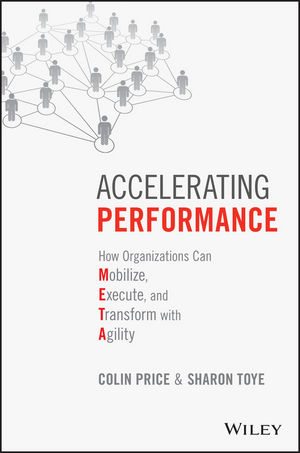Two key-words leapt out at me from the cover, (and it has to be said a fairly non-descript and minimalist cover that really doesn’t help this book standout IMHO) transform with agility. So, would this be a book with real transformational insight and showcasing corporate agility beyond the buzzword? Let’s see.
Colin Price has an impressive back story and set of qualifications in the world of business and, along with colleague Sharon Toye a key role in the consulting firm Heidrick & Struggles. It’s clear that this is a book, about a very useful model used in their consulting practice – which means it’s had plenty of road testing and utilisation and gives confidence that this is something that works. I am always keen to hear from firms who’ve developed an approach like this that works and then distilled it into a book, as a form of “giving back” to the world. It also alerts people (like me who are new to the people and the firm) about H&S and to potential clients who may want to engage them having seen their work in the open.
An opening story of a walk through London between client meetings and dinner, through a journey seeing corporate failures, political leadership scandals, media misdemeanours and general convulsive change brings a vivid picture to mind. Having now read through the rest of this book, I’d have really liked to have seen more of this vivid writing style but then that’s a preference of mine.
The remainder of the book is a really deep dive into consulting practice and helping people grasp the model – the META concept – used by the authors to good effect.
Examples of high-growth, profit-enhancing enterprises leaves you in no doubt that there’s something that works here. Something that can turn around enterprises who otherwise wouldn’t be so successful.
And yet, I’m lacking the lasting recollection of human stories and characters. The people.
Yes of COURSE the purpose of business is to grow more customers (Hat Tip Peter Drucker). Yet I see the purpose of business is people – profit being a by-product of something people want and need. Anyway, that’s more about me than this book.
I thought the model though was great, I really liked its construct. It has a clever mnemonic; though I am not keen on the word Execute, for it’s deathly connotations but it fits well in the mnemonic and the model itself, and that this is a book built on research, fact, data, and a realisation. That there is far too much – as the authors’ cleverly portmanteau it – anecdata. Too much reliance on a flimsy data set to prove one’s own view of something.
So the book is called accelerating performance. I guess it is although the word that kept coming to my mind was growth.
Growth and more growth appears to be essence of the book, the theory and the application of the model is how to deliver growth.
And yet, is it always about growth in that get larger sense?
Is it growth of impact (which may not mean profit or size), of brilliance, of resolve, of beauty, of art, of humanity, of legacy?
I came away from this book feeling that it is totally a book of this age: that success is Google, Apple, Alibaba – mega growth. If that’s what you want, I think this book could seriously help you do that. It’s got a real focus on how to build an enterprise that’s fit to get bigger and more profitable. That’s not my reason for being, so I felt a little fatigued as I read deeper into the book.
I came to life most with the final chapters on Liquid Leadership (a concept already explored by Liquid Thinker Damian Hughes in 2007) and I liked the Connect Beyond Hierarchy subtitle. There are some very useful leadership recommendations here for those yet to be enlightened in this more networked sensibility of business as it is now.
And prior to this, Chapters 15 and 16 on Resource Fluidity (a concept covered by Yves Doz and Mikko Kosonen in Fast Strategy from 2010 about Nokia, Motorola and IBM) and Dissolving Paradox.
These elements interested me the most and there was some useful information in all 3 of these chapters.
I came away thinking that If you’re an in-house or external organisation design partner, you will come to life on these chapters too – there is some useful thinking and modelling here.
So in summary, this book won’t change my practice. I’m not that sort of practitioner though. I can see it has transformational effects on growth and has some degree of agility in the way the book/model does that.
It will appeal to many people looking at a great opportunity for their enterprise to achieve scaled growth.
It has a very sound research base, is packed full of models and ways of applying them so if you’re looking to add “growth acceleration” to your consulting tactics, this book will do that for you I’m sure.
Meaning, Enjoyment, building Trust whilst Adapting is probably my personal META so I appreciate the authors giving me a chance to look at their version and craft my own from their committed, applied and successful ways.
Perry Timms, Founder and Chief Energy Officer, PTHR
Published by Wiley







